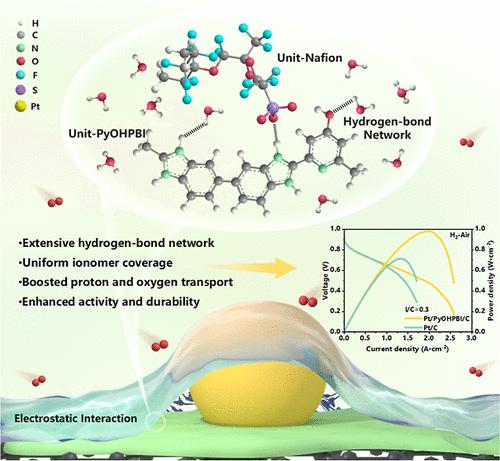聚合物支架诱导广泛的氢键网络:在阴极催化剂/离聚体界面中实现质子和氧的高传输
IF 8.2
2区 材料科学
Q1 MATERIALS SCIENCE, MULTIDISCIPLINARY
引用次数: 0
摘要
质子交换膜燃料电池(pemfc)阴极催化剂层中不均匀的离聚体覆盖阻碍了质子传导和氧扩散,特别是在铂含量低的情况下。本研究利用氢键位点丰富的羟基吡啶聚苯并咪唑(PyOHPBI)设计并构建了一个功能化聚合物支架,从而提出了一种氢键协同策略来解决优化离聚体分布和增强质子和气体通过催化剂层的传输的挑战。通过整合分子动力学模拟、原位和非原位表征方法,与商用Pt/C催化剂相比,该设计实现了144.4%的峰值功率密度,同时在膜电极组件(MEAs)中具有极低的局部氧传输阻力,仅为7.81 s·m-1。这项研究强调了碳支持物的表面化学修饰如何利用氢键来优化离聚体覆盖,显著提高了PEMFC的性能,并为开发更高效和可持续的燃料电池技术提供了见解。本文章由计算机程序翻译,如有差异,请以英文原文为准。

Polymer-Scaffold Induced Extensive Hydrogen-Bond Network: Enabling High Transport of Proton and Oxygen in Cathode Catalyst/Ionomer Interfaces
Uneven ionomer coverage in the cathode catalyst layer of proton exchange membrane fuel cells (PEMFCs) impedes proton conduction and oxygen diffusion, particularly at low platinum loadings. Here, a functionalized polymer-scaffold is designed and constructed by using hydroxy-pyridine polybenzimidazole (PyOHPBI) with abundant hydrogen-bond sites, thereby proposing a hydrogen-bond synergistic strategy to address the challenges of optimizing ionomer distribution and enhancing the transport of protons and gas through the catalyst layer. By integrating molecular dynamics simulations, in situ and ex-situ characterization methods, the design achieves 144.4% of the peak power density compared to commercial Pt/C catalysts, alongside an exceptionally low local oxygen transport resistance of only 7.81 s·m–1 in membrane electrode assemblies (MEAs). This study highlights how surface chemical modifications of carbon supports leverage hydrogen bonds to optimize ionomer coverage, significantly enhancing PEMFC performance and offering insights for developing more efficient and sustainable fuel cell technologies.
求助全文
通过发布文献求助,成功后即可免费获取论文全文。
去求助
来源期刊

ACS Applied Materials & Interfaces
工程技术-材料科学:综合
CiteScore
16.00
自引率
6.30%
发文量
4978
审稿时长
1.8 months
期刊介绍:
ACS Applied Materials & Interfaces is a leading interdisciplinary journal that brings together chemists, engineers, physicists, and biologists to explore the development and utilization of newly-discovered materials and interfacial processes for specific applications. Our journal has experienced remarkable growth since its establishment in 2009, both in terms of the number of articles published and the impact of the research showcased. We are proud to foster a truly global community, with the majority of published articles originating from outside the United States, reflecting the rapid growth of applied research worldwide.
 求助内容:
求助内容: 应助结果提醒方式:
应助结果提醒方式:


